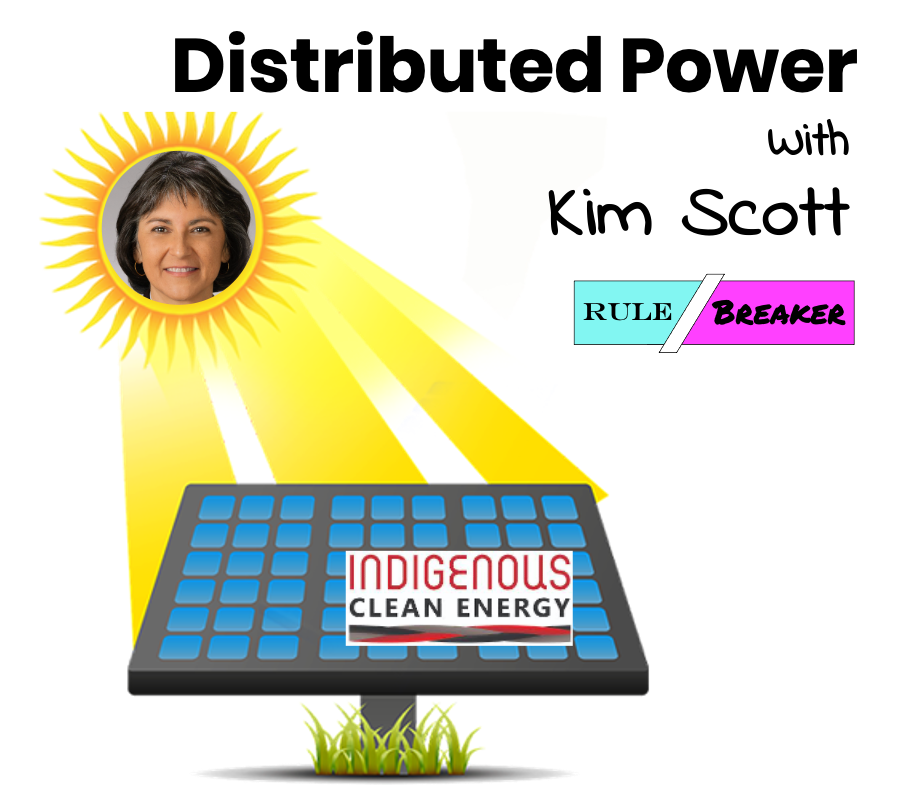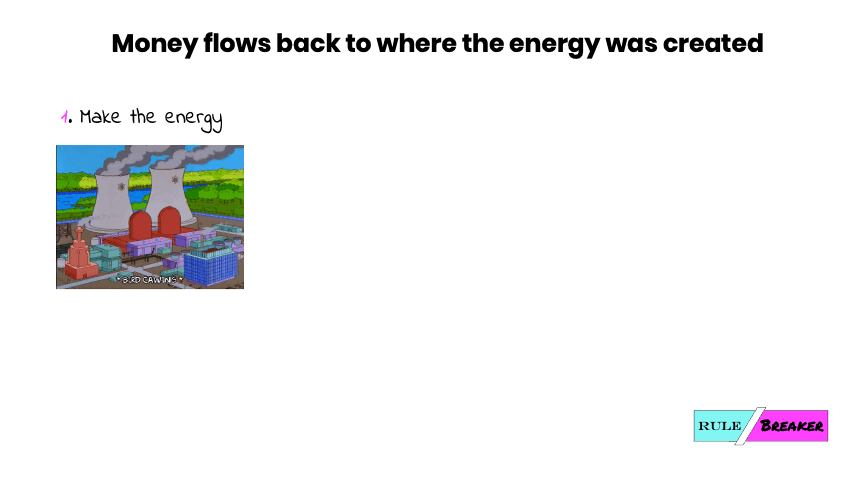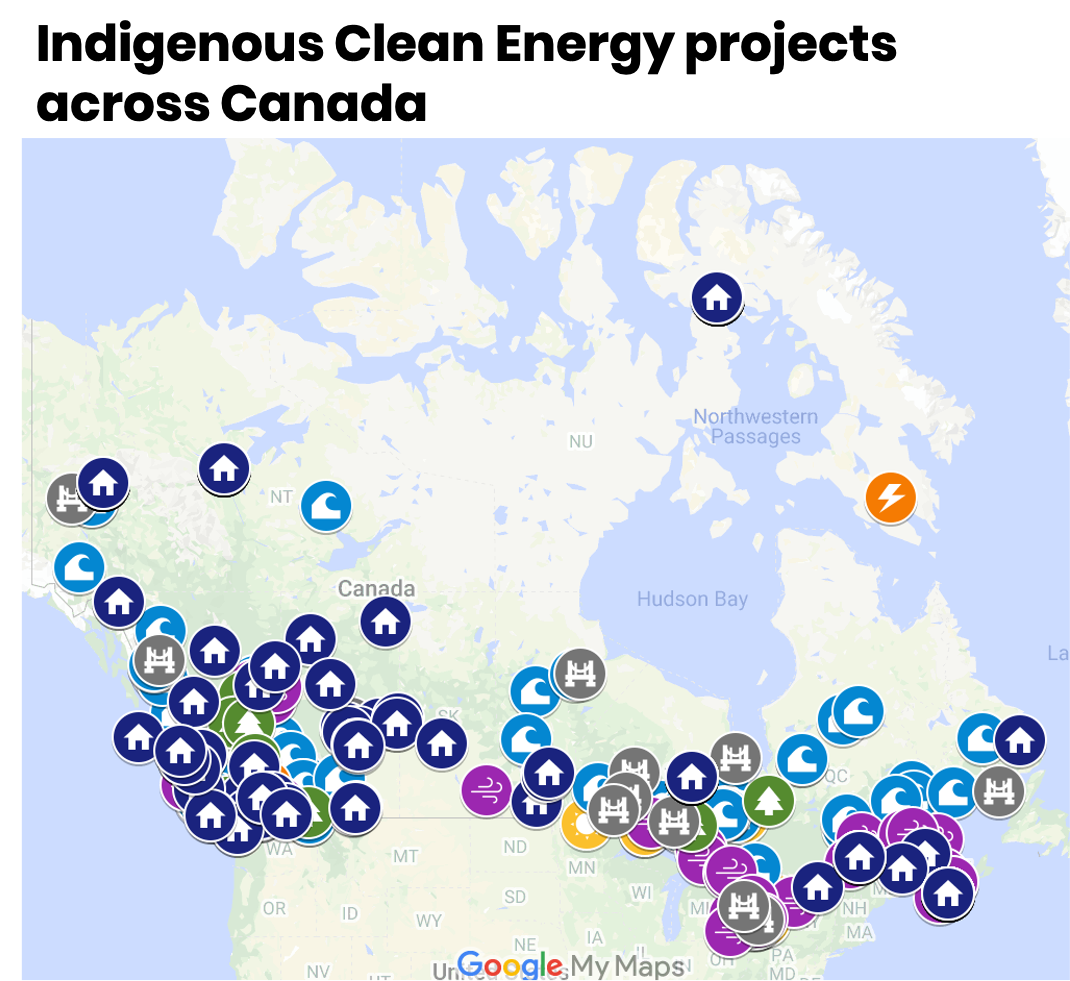👋 to all the returning folks who care about creating a sustainable and inclusive society.
For the new folks, I go deep on how some win at the exclusion of others and how to change the game.
In the hopper is why crypto is hot, real estate you can buy for $1, and up-skilling not just for the 1%. So click that pretty pink button below to join the crew.
To avoid newsletter overload set your 👀 on the 5 pictures and the parting words for the answer to today’s focus:
How renewable power is generating financial autonomy in Indigenous communities and will change the way you think about buying local.
(Pro-tip: Download images on your email viewer to get the full giffy experience)
Opening spiel
Energy is the literal and figurative fuel of our economy.
With energy we get all the things we rely on for a quality life (including love, cause how else can I see my mama during a lockdown?!).
But it goes beyond daily dependence. Kim Scott, who was building solar for her home in the ‘80s and is a co-chair of Indigenous Clean Energy Advisory Council, opened my eyes to the broader role energy plays in our society.
Now I can’t un-see how the ability to create and access power (i.e., the thing we use to charge our phones) is directly connected to the other kind of power we know needs to be shared more these days (i.e., the thing people use to direct or influence how people behave and the world unfolds).
Okay - let’s plug into the mind of Kim.
Access to power isn’t evenly distributed
Energy is a most elemental part of our lives, economy and society. Most of us are unconscious about the role because it comes to us so easily. Just plug in and you’re set.
The thing is, this access to energy and the profits from it haven’t been equally distributed.
Let’s start with the how the energy system is set up. Most systems around the world are centralized. That means that we built massive hydro dams, nuclear reactors or coal plants to generate the energy. We then built many, many kilometers of grids to get that energy to people who use it.
The reasons for a centralized system are many and include:
a) the energy sources were fixed (can’t quite move Niagara Falls closer to Toronto)
b) we didn’t want the energy creation near people (coal plans and nuclear reactors don’t make for good picnic sites)
c) it was cheaper to build big (good ol’ economies of scale!).
As a result of how we built this system, remote communities have been left out. Transporting power to every remote location would require a very large, expensive and mostly inefficient grid.
So instead, many remote communities are literally off the grid and rely on imported diesel to power their community.
It matters where your power comes from
While many might dream of living off the grid, the reality comes with challenges most haven’t considered.
Diesel power is an unstable, unclean and unsustainable way to power communities. This dirty fuel is not nice to mother nature when spilled during transport or polluting the air when burned. It’s also hella noisy, drowning out the lovely nature sounds that come along with being in a remote location.
But the negative impacts go beyond environmental issues and into severe social ones.
Being outside the system means that social or economic betterment is hamstrung by extreme electricity cost. Wanna build a better home? Electricity costs are gonna eat up too much of the budget. Wanna do more agriculture? Electricity costs are gonna make it unprofitable. Wanna run a reliable medical clinic or school? Electricity going out now and then makes the everyday just a bit crappier. You get the picture.
More so, the profits generated from this energy leave the community. Now, this happens in all communities, on and off-grid. As an example, only 12% of the energy system profits in London, Ontario stay in the municipality. That’s a big drain for one of our largest industries in the country.
For those off-grid, diesel is 10x more expensive than regular electricity and 100% externally owned. And the price of diesel just keeps on going up. That leads to a lot of cash and profits leaving the community which already has the odds stacked against it to improve their quality of life.
Indigenous communities are the most impacted
Being off-grid isn’t great and the majority of off-grid communities are Indigenous. With those two pieces of the puzzle, we can now understand how access to energy has played a significant role in the ongoing disparity between Indigenous and non-Indigenous communities.
Let me break this down...
There is a disparity between Indigenous and non-indigenous community well-being (i.e., education, labour market participation, income and housing).
This disparity has persisted for decades and in spite of the government consistently spending more and more money on things like facilities, education, food, potable water, and medicine.
Why is this so? Because things have to be transported in and then powered by diesel. And this is hella expensive.
But also, the communities remain dependent on the state. There is no profit from energy generation (the most central thing to an economy) that stays in the community to be reinvested.
And with no local economy where profits from one thing can be invested into another there is no progress.
Essentially, the lack of clean, reliable and inexpensive energy stymies a lot of local and sustainable development.

Cleaner power leads to better power
If Canada accounted for the costs of importing all food, medicine, energy, and expertise to service remote and isolated Indigenous communities, investments in community-owned power would seem inexpensive by comparison.
- Kim Scott
The exciting bit is that energy technology has come a long way. We don’t have to rely on large power generators, kilometers of grids to get us the energy and fork over all our money to some distant provider.
Insert Indigenous Clean Energy. They are helping Indigenous communities install and access their own local renewable energy using wind, solar, hydro, or biomass.
The scale is impressive. Indigenous communities and their partners are generating 19% of Canada’s electricity.
The social impact though, is even more impressive. When these communities produce power where they live and work (i.e., distributed energy vs. the centralized stuff most of us are hooked up to), they enjoy more energy democracy.
As Kim explains, energy democracy is created when energy production is decentralized and there is movement away from monopoly ownership to community ownership, thereby increasing local and democratic decision-making power over profits, jobs, and investments.
Much of the power generation is either wholly or jointly owned by the community. This means the local community gains skills and employment in an important sector AND have a fairer share of the economic pie.
With the profits they make from the energy generation, they can then put that towards the unique community needs - be it more local agriculture, schools, childcare, sports facilities etc. This is how the Indigenous communities shift from dependency to autonomy.
Basically, distributed power projects lead to the other kind of power that Indigenous communities have been stripped of: local decision making.
With a platform for energy security, the localization of other goods and services (e.g., food production) is possible, thereby reducing the need for expensive, unsustainable imports from faraway producers.
- Kim Scott
The shining example (pun intended) is T’Sou-ke first nation, led by Chief Gordon Planes. It started with $25,000 BC government funding for a solar project in 2009. From there it led them to be the most solar intensive community in Canada that also feeds renewable energy back into the main system. And because they now own the power generator, the profits from this most elemental utility are reinvested back into the community, including their commercial wasabi plantation and oyster farm that brought in $100,000 in revenue in the first harvest year.
To get this community flourishing, they needed involvement in the game and an opportunity to chart their own course (i.e., power). That started with being able to have access to reliable and sustainable energy and then keeping the profits to reinvest back into their community as they saw fit.
Parting Words
Energy is the substrate of the economy.
Because of their remote location, Indigenous communities have largely been left out of the energy system and quality of life has suffered greatly.
By generating their own renewable energy, Indigenous communities access this essential resource in a sustainable way AND can reinvest profits to fuel further progress.
The Beatles tell us that all you need is love. But actually, all you need is energy. From there, you can get all the other things you need.
The final mic drop goes to Kim:
Further support of local energy-system ownership would form a solid foundation for economic reconciliation and inclusion in changing world economies.
Liked this? I’ve got more coming on why crypto is hot, real estate you can buy for $1, and up-skilling that doesn’t help the 1%. So, obvi you gotta subscribe.
Wanna go down the rabbit hole of distributed energy systems? Here’s more on…
~ The concepts
Distributed energy and why distributed energy is the best way to decarbonize our future according to the President and CEO Canadian Electricity Association, Francis Bradley
Energy democracy and energy security - some technical terms of what’s happening here.
Reconciliation and Energy Democracy - Kim’s paper that spells out policy drivers to amplify Indigenous inclusion in the energy transition and performance indicators to determine the extent to which Canada is advancing on reconciliation and energy democracy.
~ Indigenous success stories in Canada
T’Sou-ke first nation and their $25,000 in BC government funding that led to much more, including a wasabi plantation and oyster farm success
Gull Bay video on their clean energy and financial autonomy story. Also summed up in a presentation to the Harvard Kennedy School of Public Policy.
“Aboriginal Power” book by Chris Henderson on the myriad of stories that shows how renewable, locally owned energy leads to Indigenous flourishing.
~ What else is happening in Canada and abroad
Community energy projects popping up across Canada. They allow local ownership of sustainable energy production.
Ottawa Renewable Energy Cooperative is open for citizen investment.
Germany is considered a global leader in renewable energy and the shift from centralized power generation to a decentralized system. Nearly a third of the renewable energy in Germany is owned by regular citizens. That’s more than the utilities, banks and funds combined. Seriously. Check out the link ^.
Minigrids are acting as a seed of change in Cameroon - similar to what happens in Indigenous communities in Canada.
And if you really wanna get into the electricity grid - Canadian Geographic sells a floor map (a COVID homeschooling adventure?)
Many many thanks to Kim for lending me her time and brain. And to Dan and Lara for inspiration and input.
Since you made it this far, I suggest subscribing or sharing (cause sharing is caring 💕)
🦦
Jess










